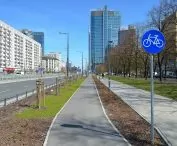Who are city sidewalks really for? To what extent will changes in the traffic law affect the city's space? It turns out that after years of discussion, the need for a change in the law to ensure residents' safety has been recognized. It took effect at the end of May 2021, but will it be safer for sure?
two years after the consultation...
Despite the fact that public consultations took place more than two years ago, and the Ministry of Infrastructure developed a plan, the change in the traffic law only took effect a few days ago, on May 19, 2021. The question of the need for this change seems superfluous, probably everyone has once encountered an electric scooter thrown in the middle of the sidewalk, or surprised an electric skateboard flashing at the speed of a scooter, but on the bike path... Or maybe it was an electric bicycle? Undoubtedly, the development of technology over the past few years can be considered dynamic, meanwhile, traffic regulations have so far been indifferent to it. But in the end, after minor amendments, the resolution signed by the President went into effect. What are the changes?
new traffic participants
A new category of traffic participants has emerged, and among them are so-called users of assistive traffic devices. What kind of devices are these? Among others, "designed to move in a standing position, powered by muscle power." And here, questions arise. Wasn't the impetus for the change caused by electric vehicles moving too fast on sidewalks causing confusion and danger? Why a new category? Who are the movers of classic skateboards or scooters? According to the regulation in effect until 19.05.2021. "mobility aids" do not meet any of the statutory definitions of a vehicle, so they are not considered vehicles. People using them are on the road outside of vehicles. Are they further pedestrians?
electric and non-electric
The second major change is the definition of the technical requirements of electric scooters. "An electrically-powered, two-axle vehicle with a steering wheel, without a seat or pedals, structurally designed to be driven solely by the rider on the vehicle." Previously treated as mopeds, yet without registration, they have legally traveled on sidewalks, often at the same speed as vehicles on the street... As well as electric scooters, so-called personal transportation devices have become completely legal. What is this? This is an electrically-powered vehicle, excluding electric scooters, without a seat or pedals, structurally designed to be driven only by the driver on the vehicle. So you will be able to legally ride on public roads on anything that has wheels and is electric - as long as it doesn't have a saddle. Why? The government's justification reads:
(...) Vehicles equipped with a saddle were not included in the regulation in question, because after a substantive analysis of the issue, it was considered that the inclusion of such devices in the definition of an electric scooter could impair traffic safety, particularly for pedestrians.
So who are city sidewalks really for from May 19, 2021?
Currently, in addition to cyclists, the roads for cyclists should be used by:
- users of mobility aids, i.e. scooters, skateboards, rollerblades, driving an electric scooter.
- Those driving a personal transportation device, the so-called UTO. This category includes segways, electric monocycles and electric skateboards, among others.
Meanwhile, users of a "traditional" scooter, skateboard, rollerblades or roller skates have a choice between the sidewalk, the pedestrian road and the bicycle road.
If they choose the latter, they are required to be close to the right edge, and if the road is intended in the opposite direction to the one they want to travel, they should use the sidewalk or pedestrian road.
In theory, it was supposed to be safer, meanwhile, it turns out that all those devices whose presence on sidewalks was questionable have simply become officially legal there now. In addition, the regulations are not consistent with each other, some being mutually exclusive, once forbidding crossing the roadway with a vehicle, other times suggesting only "appropriate use." The changes include several other regulations, which you can read about HERE. All users of the city's sidewalks and bike paths should familiarize themselves with the revised regulations, although their interpretation is unfortunately not always obvious even to experts....















